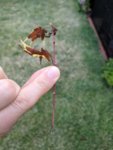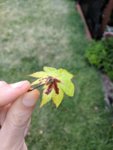I was trying to root some cultivars and was experimenting with higher concentrations of auxins. Cuttings were washed in 900ppm hydrogen peroxide, wounded at the base, dipped and then stuck. The first images below are of A.p. 'Summer Gold' rooted in 3000ppm IBA / 1500ppm NAA (Dip N Grow), 12 days after planting. The cuttings were kept under domes at 95% humidity with bottom heat at 85F.
The failure mode is very interesting: the leaves did not dry out, instead the petiole died and necrosis spread from the end of the petiole out into the center of the leaf. You can also see the wounded area died at the base. However, the buds are still healthy and when I cut the branch tissue it was green and healthy above the necrotic area.
Other interesting facts: all the leaves on this cutting died and dropped off, as did a couple of others. However, I have a 6 more that look perfectly fine. More interesting: I tried some Arakawa at an even higher concentration (4000ppm IBA / 2000ppm NAA) and they seem perfectly healthy -- even pushing new growth! So maybe even within a species there are varying responses to auxins among different cultivars.
This is why you don't overdo rooting hormones. At least -- that's the lesson I took from it. Would be interested to hear from someone like @0soyoung that might have more insight!
The failure mode is very interesting: the leaves did not dry out, instead the petiole died and necrosis spread from the end of the petiole out into the center of the leaf. You can also see the wounded area died at the base. However, the buds are still healthy and when I cut the branch tissue it was green and healthy above the necrotic area.
Other interesting facts: all the leaves on this cutting died and dropped off, as did a couple of others. However, I have a 6 more that look perfectly fine. More interesting: I tried some Arakawa at an even higher concentration (4000ppm IBA / 2000ppm NAA) and they seem perfectly healthy -- even pushing new growth! So maybe even within a species there are varying responses to auxins among different cultivars.
This is why you don't overdo rooting hormones. At least -- that's the lesson I took from it. Would be interested to hear from someone like @0soyoung that might have more insight!



